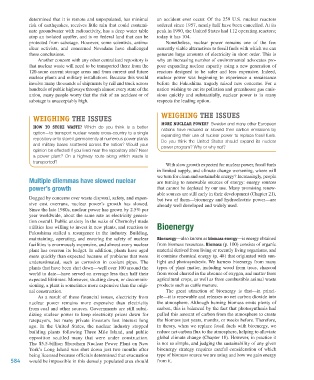Page 585 - Environment: The Science Behind the Stories
P. 585
determined that it is remote and unpopulated, has minimal an accident ever occur. Of the 259 U.S. nuclear reactors
risk of earthquakes, receives little rain that could contami- ordered since 1957, nearly half have been cancelled. At its
nate groundwater with radioactivity, has a deep water table peak in 1990, the United States had 112 operating reactors;
atop an isolated aquifer, and is on federal land that can be today it has 104.
protected from sabotage. However, some scientists, antinu- Nonetheless, nuclear power remains one of the few
clear activists, and concerned Nevadans have challenged currently viable alternatives to fossil fuels with which we can
these conclusions. generate large amounts of electricity in short order. This is
Another concern with any other centralized repository is why an increasing number of environmental advocates pro-
that nuclear waste will need to be transported there from the pose expanding nuclear capacity using a new generation of
120-some current storage areas and from current and future reactors designed to be safer and less expensive. Indeed,
nuclear plants and military installations. Because this would nuclear power was beginning to experience a renaissance
involve many thousands of shipments by rail and truck across before the Fukushima tragedy raised new concerns. For a
hundreds of public highways through almost every state of the nation wishing to cut its pollution and greenhouse gas emis-
union, many people worry that the risk of an accident or of sions quickly and substantially, nuclear power is in many
sabotage is unacceptably high. respects the leading option.
WEIGHING THE ISSUES WEIGHING THE ISSUES
MORE NUCLEAR POWER? Sweden and many other European
HOW TO STORE WASTE? Which do you think is a better nations have reduced or slowed their carbon emissions by
option—to transport nuclear waste cross-country to a single expanding their use of nuclear power to replace fossil fuels.
repository or to store it permanently at numerous power plants Do you think the United States should expand its nuclear
and military bases scattered across the nation? Would your power program? Why or why not?
opinion be affected if you lived near the repository site? Near
a power plant? On a highway route along which waste is
transported?
With slow growth expected for nuclear power, fossil fuels
in limited supply, and climate change worsening, where will
we turn for clean and sustainable energy? Increasingly, people
Multiple dilemmas have slowed nuclear are turning to renewable sources of energy: energy sources
power’s growth that cannot be depleted by our use. Many promising renew-
able sources are still early in their development (Chapter 21),
Dogged by concerns over waste disposal, safety, and expen- but two of them—bioenergy and hydroelectric power—are
sive cost overruns, nuclear power’s growth has slowed. already well developed and widely used.
Since the late 1980s, nuclear power has grown by 2.5% per
year worldwide, about the same rate as electricity genera-
tion overall. Public anxiety in the wake of Chernobyl made
utilities less willing to invest in new plants, and reaction to Bioenergy
Fukushima stalled a resurgence in the industry. Building,
maintaining, operating, and ensuring the safety of nuclear Bioenergy—also known as biomass energy—is energy obtained
facilities is enormously expensive, and almost every nuclear from biomass resources. Biomass (p. 100) consists of organic
plant has overrun its budget. In addition, plants have aged material derived from living or recently living organisms, and
more quickly than expected because of problems that were it contains chemical energy (p. 48) that originated with sun-
underestimated, such as corrosion in coolant pipes. The light and photosynthesis. We harness bioenergy from many
plants that have been shut down—well over 100 around the types of plant matter, including wood from trees, charcoal
world to date—have served on average less than half their from wood charred in the absence of oxygen, and matter from
expected lifetimes. Moreover, shutting down, or decommis- agricultural crops, as well as from combustible animal waste
sioning, a plant is sometimes more expensive than the origi- products such as cattle manure.
nal construction. The great attraction of bioenergy is that—in princi-
As a result of these financial issues, electricity from ple—it is renewable and releases no net carbon dioxide into
nuclear power remains more expensive than electricity the atmosphere. Although burning biomass emits plenty of
from coal and other sources. Governments are still subsi- carbon, this is balanced by the fact that photosynthesis had
dizing nuclear power to keep electricity prices down for pulled this amount of carbon from the atmosphere to create
ratepayers, but many private investors lost interest long the biomass just years, months, or weeks before. Therefore,
ago. In the United States, the nuclear industry stopped in theory, when we replace fossil fuels with bioenergy, we
building plants following Three Mile Island, and public reduce net carbon flux to the atmosphere, helping to alleviate
opposition scuttled many that were under construction. global climate change (Chapter 18). However, in practice it
The $5.5-billion Shoreham Nuclear Power Plant on New is not so simple, and judging the sustainability of any given
York’s Long Island was shut down just two months after bioenergy strategy requires careful consideration of which
being licensed because officials determined that evacuation type of biomass source we are using and how we gain energy
584 would be impossible in this densely populated area should from it.
M20_WITH7428_05_SE_C20.indd 584 13/12/14 1:56 PM

